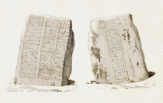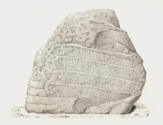- Gorm, Thyra and Harald
- The rune stones
- Gorm the Old’s rune stone
- Harald Bluetooth’s rune stone
- Basse’s rune stone
- How are rune stones read?
- The rune stones past and present
- Henrik Rantzau’s view, 1591
- Jon Skonvig, 1627
- Søren Abildgaard, 1771
- Ole Jørgen Rawert, 1819
- Adam Müller, 1835
- Jakob Kornerup, 1861
- Julius Magnus-Petersen, 1869-71
- Julius Magnus-Petersen, 1878
- Hans Andersen Kjær, 1897
- Photographs by a member of the public, 1935
- Runologist Erik Moltke, 1971
- Ludvig Stubbe-Teglbjærg’s rubbings, 1973
- Peter Henrichsen, moulding and copying in 1984
- Roberto Fortuna, 2006
- The conservation investigation 2006-08
- 3D light scanning, 2007
- Harald Bluetooth’s rune stone at home and abroad
- Pictures from Jelling
Jakob Kornerup, 1861
Jakob Kornerup (1825-1913) had many talents. He was an illustrator, painter, archaeologist and conservator. In 1861 he came to Jelling to draw the two rune stones and later the same year the drawings were converted into engravings. The archaeologist C. F. Herbst wrote to the chairman of the Antiquities Commission C. J. Thomsen on July 31 1861 that “the rune stones near the church are being drawn by Kornerup with the greatest attention to detail. His drawings contain many, in some cases, important corrections of Adam Müller’s drawings, although these really are highly respectable.”
Kornerup’s drawings give a realistic and detailed picture of the two rune stones. However, he has chosen to reproduce the animal and Christ side on Harald’s large rune stone in the same drawing, for which reason the two sides are slightly slanting. For the same reason the damage at the edges bordering the text side cannot be seen. Broken-off areas are drawn relatively precisely with reasonably clear edges, whilst cracks are more diffuse.
The front side on Gorm’s small rune stone has the same missing area in the words karþi and aft in the second and third lines that Adam Müller reproduced in 1835. In addition, Kornerup does not show the broken-off piece, which can be seen today in the word kurmR in the first line. On the back side he has marked moss or lichen. This is in spite of the fact that, as C. F. Herbst noted in his diary, the rune stones were scrubbed for five days in a row. The drawing also shows that at that time Gorm’s rune stone leant to the west. Since then it has been adjusted so that it stands upright.
The cracks on the text side of Harald’s rune stone have approximately the same extent as in Adam Müller’s drawing of 1835, but are overall slightly longer. In addition, Kornerup has marked the damage in the inscription’s first line in the word haraltr. At the bottom of the side Kornerup has drawn a large broken-off area. This is not recorded by Müller and must therefore have appeared in the period between 1835 and 1861. Furthermore, there are broken-off areas in the bottom half of the runes in the sequence sąR. The large crack on the animal side which runs downwards from the large triangular broken-off piece to the back of the animal’s head, is of the same length as it is today. Kornerup has also drawn in several smaller cracks, including a crack at the animal’s right rear hock, a crack in the tail and a crack in the snake’s acanthus tail. In addition, at the bottom of this side several cracks are shown under the runic inscription. On the Christ side is a fragmentary runic inscription drawn in the same way as by Müller in 1835. The decomposition of the inscription has thus probably not increased in the intervening period. On the other hand, the breakdown of the broken-off piece in the large triquetra on the left has clearly increased compared to Müller’s drawing. Today this area is even further broken down, which is a worrying development.




